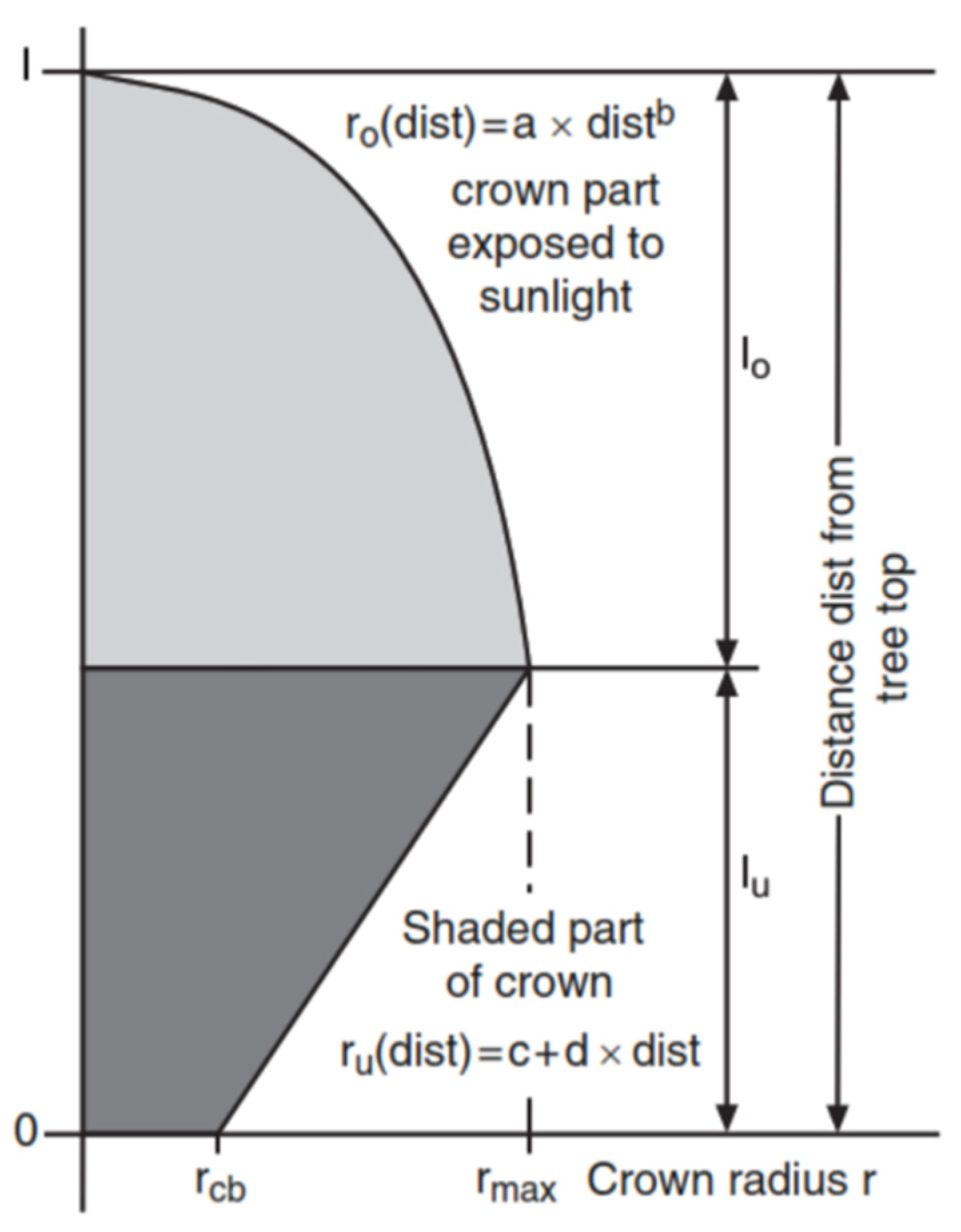Single Tree Stability Assessment in Beech High Forest and Factors that Could Induce Windbreak †
Abstract
:1. Introduction
2. Materials and Methods
2.1. Site Description
2.2. Experimental Design
- -
- Maximum height of the tree;
- -
- Crown insertion height;
- -
- Point of crown maximum width height;
- -
- Presence/absence of the “castle”, insertion of the most major branches at the same point;
- -
- Height of the castle;
- -
- Crown projection on the ground detected measuring four radius called: “dx”, “sx”, “c” and “c1”, where “c1” corresponds to the fall direction (for standing trees, this was considered the fall direction of the corresponding crashed tree);
- -
- Fall direction.
2.3. Data Collection and Analysis
2.4. Statistical Analysis
3. Results and Discussion
4. Conclusions
Funding
Acknowledgments
Conflicts of Interest
References
- Reyer, C.P.; Bathgate, S.; Blennow, K.; Borges, J.G.; Bugmann, H.; Delzon, S.; Faias, S.P.; Garcia-Gonzalo, J.; Gardiner, B.; Gonzalez-Olabarria, J.R. Are forest disturbances amplifying or canceling out climate change-induced productivity changes in European forests? Environ. Res. Lett. 2017, 12, 034027. [Google Scholar] [CrossRef] [PubMed]
- Gopalakrishnan, R.; Packalen, P.; Ikonen, V.P.; Räty, J.; Venäläinen, A.; Laapas, M.; Pirinen, P.; Peltola, H. The utility of fused airborne laser scanning and multispectral data for improved wind damage risk assessment over a managed forest landscape in Finland. Ann. For. Sci. 2020, 77, 97. [Google Scholar] [CrossRef]
- Mäenpää, H.; Peura, M.; Halme, P.; Siitonen, J.; Mönkkönen, M.; Oldén, A. Windthrow in streamside key habitats: Effects of buffer strip width and selective logging. For. Ecol. Manag. 2020, 475. [Google Scholar] [CrossRef]
- Sani, L. Valutazione Integrata dell’albero; Nicomp Laboratorio Editoriale: Firenze, Italy, 2008; p. 176. [Google Scholar]
- Taeroe, A.; de Koning, J.H.C.; Löf, M.; Tolvanen, A.; Heiðarsson, L.; Raulund-Rasmussen, K. Recovery of temperate and boreal forests after windthrow and the impacts of salvage logging. A quantitative review. For. Ecol. Manag. 2019, 446, 304–316. [Google Scholar] [CrossRef]
- Ochtyra, A. Forest Disturbances in Polish Tatra Mountains for 1985–2016 in Relation to Topography, Stand Features, and Protection Zone. Forests 2020, 11, 579. [Google Scholar] [CrossRef]
- Pretzsch, H. Description and Analysis of Stand Structures. In Forest Dynamics, Growth and Yield; Springer: Berlin, Germany, 2008; pp. 223–289. [Google Scholar]
- Dunham, R.A.; Cameron, A.D. Crown, stem and wood properties of wind damaged and undamaged Sitka spruce. For. Ecol. Manag. 2000, 135, 7381. [Google Scholar] [CrossRef]
- Urata, T.; Shibuya, M.; Koizumi, A.; Torita, H.; Cha, J.Y. Both stem and crown mass affect tree resistance to uprooting. J. For. Res. 2012, 17, 65–71. [Google Scholar] [CrossRef]
- Ancelin, P.; Courbaud, B.; Fourcaud, T. Development of an individual tree-based mechanical model to predict wind damage within forest stands. For. Ecol. Manag. 2004, 203, 101–121. [Google Scholar] [CrossRef]
- Bergeron, C.; Ruel, J.C.; Elie, J.C.; Mitchell, S.J. Root anchorage and stem strength of black spruce (Picea mariana) trees in regular and irregular stands. Forestry 2009, 82, 29–41. [Google Scholar] [CrossRef]
- Koizumi, A. Studies on the estimation of the mechanical properties of standing trees by non-destructive bending test. In Research Bulletins of the College Experiment Forests-Hokkaido University (Japan); Hokkaido University: Sapporo, Japan, 1987. [Google Scholar]
- Bernetti, G. Le Piante del Bosco: Forme, Vita e Gestione; Compagnia delle Foreste: Arezzo, Italy, 2015; p. 350. [Google Scholar]
- Sellier, D.; Fourcaud, T. Crown structure and wood properties: Influence on tree sway and response to high winds. Am. J. Bot. 2009, 96, 885–896. [Google Scholar] [CrossRef] [PubMed]

| p-Value | |||
|---|---|---|---|
| Parameters | ANOVA | Two-Way ANOVA | t-Test |
| Hmax | 0.05069 | 0.92667 | 0.000741 |
| H1ramo | 0.76871 | 0.56910 | - |
| Hcastello | 0.27658 | 0.95223 | - |
| Hlargmaxchioma | 0.58540 | 0.71681 | - |
| S_chioma | 0.01064 | 0.54663 | 0.000282 |
| V_chioma | 0.00587 | 0.28975 | 0.000298 |
Publisher’s Note: MDPI stays neutral with regard to jurisdictional claims in published maps and institutional affiliations. |
© 2020 by the authors. Licensee MDPI, Basel, Switzerland. This article is an open access article distributed under the terms and conditions of the Creative Commons Attribution (CC BY) license (https://creativecommons.org/licenses/by/4.0/).
Share and Cite
Gennari, E.; Latterini, F.; Venanzi, R.; Monaco, A.L.; Picchio, R. Single Tree Stability Assessment in Beech High Forest and Factors that Could Induce Windbreak. Environ. Sci. Proc. 2021, 3, 60. https://doi.org/10.3390/IECF2020-07953
Gennari E, Latterini F, Venanzi R, Monaco AL, Picchio R. Single Tree Stability Assessment in Beech High Forest and Factors that Could Induce Windbreak. Environmental Sciences Proceedings. 2021; 3(1):60. https://doi.org/10.3390/IECF2020-07953
Chicago/Turabian StyleGennari, Emiliano, Francesco Latterini, Rachele Venanzi, Angela Lo Monaco, and Rodolfo Picchio. 2021. "Single Tree Stability Assessment in Beech High Forest and Factors that Could Induce Windbreak" Environmental Sciences Proceedings 3, no. 1: 60. https://doi.org/10.3390/IECF2020-07953
APA StyleGennari, E., Latterini, F., Venanzi, R., Monaco, A. L., & Picchio, R. (2021). Single Tree Stability Assessment in Beech High Forest and Factors that Could Induce Windbreak. Environmental Sciences Proceedings, 3(1), 60. https://doi.org/10.3390/IECF2020-07953










